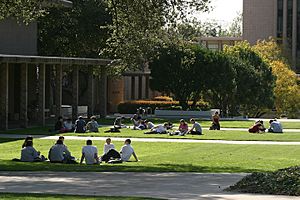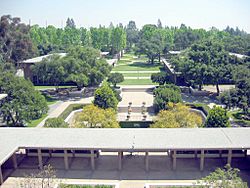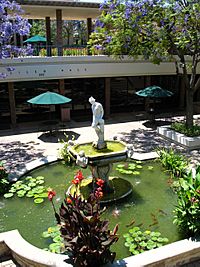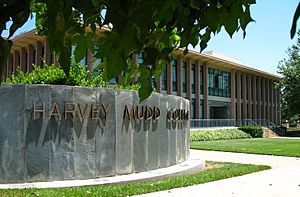Harvey Mudd College facts for kids
 |
|
| Type | Private college |
|---|---|
| Established | 1955 |
|
Academic affiliations
|
Claremont Colleges NAICU Oberlin Group Annapolis Group CLAC |
| Endowment | $319.7 million (2020) |
| Budget | $72 million (2019) |
| President | Maria Klawe |
|
Academic staff
|
130 (2021) |
| Undergraduates | 905 (2021) |
| Location |
,
U.S.
|
| Campus | Suburban, 38 acres (15 ha) |
| Colors | Black & gold |
| Nickname | Stags (men) / Athenas (women) |
| Mascot | Official: Men's, Stag Women's, Athenas Unofficial: Wally Wart |
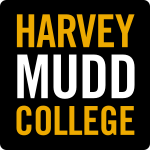 |
|
Harvey Mudd College (HMC) is a private college in Claremont, California, focused on science and engineering. It is part of the Claremont Colleges, which share adjoining campus grounds and resources. The college enrolls 902 undergraduate students as of 2021[update], and awards the Bachelor of Science degree.
The college was funded by the friends and family of Harvey Seeley Mudd, one of the initial investors in the Cyprus Mines Corporation, and named in his honor. Although involved in planning of the new institution, Mudd died before it opened in 1955. The campus was designed by Edward Durell Stone in a modernist style.
Admission to Harvey Mudd is highly competitive, and the college is known for its intense academic culture. Graduates earn the highest mid-career salaries of any college or university in the United States, according to data from payscale.com.
History
Harvey Mudd was founded in 1955. Classes began in 1957, with a founding class of 48 students and one building–Mildred E. Mudd Hall, a dormitory. Classes and meals took place at CMC, and labs in the Baxter Science Building until additional buildings could be built: Jacobs Science Building (1959), Thomas-Garett Hall (1961) and Platt Campus Center (1963). By 1966, the campus had grown to 283 students and 43 faculty.
Under the presidency of Maria Klawe, begun in 2006, Harvey Mudd became a leading advocate for women in STEM in higher education.
In April 2017, all classes were canceled for two days in response to tensions on campus over workload, race issues, and mistrust of faculty. Contributing events included the deaths of two Mudd students and a Scripps student that year and the leak of a report on teaching, learning, and workload at Mudd.
Campus
The original buildings of campus, designed by Edward Durell Stone and completed in 1959, features "knobbly concrete squares that students of Harvey Mudd affectionately call 'warts' and use as hooks for skateboards." The school's unofficial mascot "Wally Wart" is an anthropomorphic concrete wart.
In 2013, Travel and Leisure named the college as one of "America's ugliest college campuses" and noted that while Stone regarded his design as a "Modernist masterpiece" the result was "layering drab, slab-sided buildings with Beaux-Arts decoration."
Academic buildings
The official names for the academic buildings of Harvey Mudd College are:
- F.W. Olin Science Center
- Parsons Engineering Building
- R. Michael Shanahan Center for Teaching and Learning
- Jacobs Science Center
- W.M. Keck Laboratories
- Scott A. McGregor Computer Science Center
Dormitories
The official names for the dormitories of Harvey Mudd College are (listed in order of construction):
- Mildred E. Mudd Hall ("East") - 1957
- West Hall ("West") - 1958
- North Hall ("North") - 1959
- Marks Residence Hall ("South") - 1968
- J. L. Atwood Residence Hall ("Atwood") - 1981
- Case Residence Hall ("Case") - 1985
- Ronald and Maxine Linde Residence Hall ("Linde") - 1993
- Frederick and Susan Sontag Residence Hall ("Sontag") - 2004
- Wayne and Julie Drinkward Residence Hall ("Drinkward") - 2015
Until the addition of the Linde and Sontag dorms, Atwood and Case dorms were occasionally referred to as New Dorm and New Dorm II; Mildred E. Mudd Hall and Marks Hall are almost invariably referred to as East dorm and South dorm.
During the construction of Case Dorm some students decided as a prank to move all of the survey stakes exactly six inches in one direction.
"East" was the first dorm, but it wasn't until "West" was built west of it that it was actually referred to as "East". Then "North" was built, directly north of "East". When the fourth dorm (Marks) was built, there was one corner of the quad available (the northwest) and one directional name, "South", remaining. To this day "South" dorm is the northernmost HMC dorm.
The fifth, sixth, seventh, eighth, and ninth dorms built are Atwood, Case, Linde, Sontag, and Drinkward, respectively. They were initially referred to as "the colonies" by some students, a reference to the fact that they were newer and at the farthest end of the campus; these dorms are now more commonly referred to as "the outer dorms." The college had initially purchased an apartment building adjacent to the newer dorms to house additional students, but it was demolished to make room for Sontag.
Since any HMC student, regardless of class year, can live in any of the dormitories, several of the dorms have accumulated long-standing traditions and so-called 'personalities'.
Academics
HMC offers four-year degrees in chemistry, mathematics, physics, computer science, biology, and engineering, interdisciplinary degrees in mathematical biology, and joint majors in computer science and mathematics; physics and mathematics; or biology and chemistry. Students may also elect an Individual Program of Study (IPS) or an off-campus major offered by any of the other Claremont Colleges, provided one also completes a minor in one of the technical fields that Harvey Mudd offers as a major.
All HMC students are required to take the college's Common Core Curriculum, typically throughout their freshman and sophomore years. This includes courses in computer science, engineering, biology, chemistry, physics, mathematics, writing, and a critical inquiry course.
In 2018, the Chronicle of Higher Education reported that, in response to student "complaints first to mental-health counselors and then to outside evaluators", the college was "considering how to ease pressure on students without sacrificing rigor."
Admissions



